|
July 25
Our wake-up call came at 5:30, and
we were on the road by half past six. It was time to leave Hwange.
On the way to the gate Mary, Jineen, Sally, Mike and I were in
Adam’s vehicle; Julian told us to be sure to ask him to stop
often and back up for birds, just for old times’ sake.
We watched the sun rise as we
drove across the flat, open plain. There were more animals around
this morning; impala, warthogs, zebra and giraffe. A mother
elephant stood in the bushes not far from the road, shielding
her small baby from our view. A rock hyrax darted across an
outcropping, and a tawny eagle perched high in a tree. We stopped
briefly at the Masuma blind; it was nearly deserted - there were a
few birds down by the water but no animals.
Moving on we saw cheetah prints in
the dusty road, and a square stone signpost with cheetah scat on
top of it. Adam explained that cheetahs had become very rare and
we were unlikely to see any; very sad as they are one of my very
favorite animals. We photographed the dung on the signpost - it
ended up being the closest we got to a cheetah on the whole trip.
|
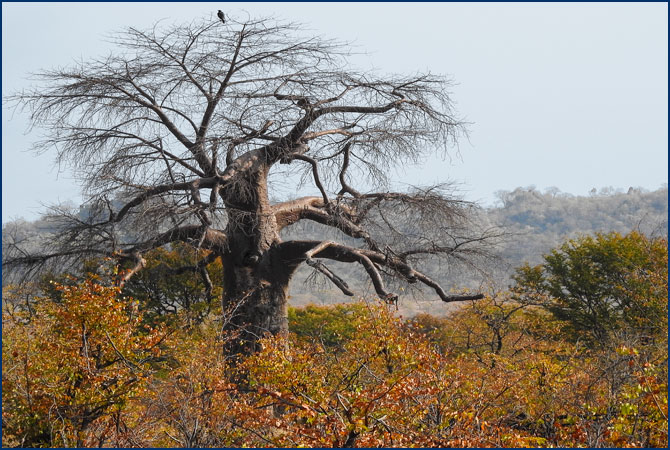
Baobab Tree
|
As we neared the gate we went through an area of steep
ridges crowned with ancient baobab trees. Two big kudu bulls ran
across the road, with magnificent twisting horns over three feet
long. A troop of baboons paraded beside the road, unembarrassed by
their ugly bald butts. A dark-chanting goshawk perched in a baobab
tree. Adam spotted a lone lioness; she was lying in the shade of a
fallen tree, well camouflaged, a hundred yards from the road.
|
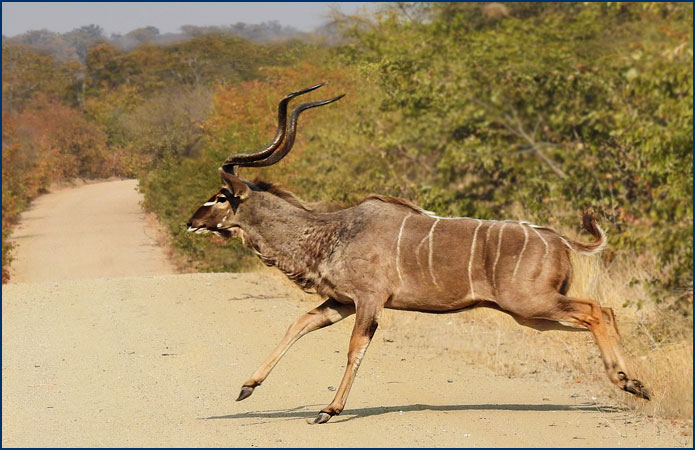
Kudu
|
We
said goodbye to Adam and Julian at the Hwange gate, and boarded a
small bus which drove us two hours back to Victoria Falls. There
we transferred to yet another bus, which took us to the
Zimbabwe/Botswana border station. It was not time to cross the
border yet; Imbabala Lodge was nearby on the Zimbabwe side. We
were met by our guide Stan, who took us to the lodge just in time
for lunch.
Imbabala looks down over the
Zambezi River; we could see Zambia on the other side. It was a
very nice lodge, a bit fancier than Hwange. The main building had
a comfortable lounging area and a bar. It had Wi-Fi; Nick was in
heaven! We teased him a bit – how could he live without being
connected? But in truth we were all glad to use email to touch
base with the folks back home.
The lodge was surrounded by a
manicured lawn, landscaped with flowers and shrubs, and shaded by
many large trees. Water sprinklers worked overtime to keep the
grass green. Our rooms were really nice individual rondovals with
thick thatched roofs. They had raised front porches with patterns
of native tile in the floor. The door had hand-carved wooden
handles, and the room keys were attached to little animals made of
beads.
The
dining table was out under a huge tree, with a brick walkway and
patio beside it. There was a row of chairs nearby with a good view
down over the river. We could see hippos in the distance, grazing
on the far shore, and also a long-horned cow down by the water. A
wart hog sauntered across the lawn, and from a nearby tree a
go-away bird called out its non-welcoming refrain. ‘Go
away. Go Away!’
In
the afternoon Stan took us for a game drive. His vehicle had three
tiers of bench seats, so all eight of us fit with no problem. We
started out down along the floodplain by the river.
We passed the mandatory impala, warthogs and baboons right
away.
The river flat was a birder’s
paradise. Along the water there were egrets, spoonbills, a squacco
heron and a goliath heron. A white-backed vulture perched in a
treetop, and a pair of African skimmers flew above the reeds. As
we continued through the scrubby trees Sally added a tropical
boubou, a bronze-winged courser, an African stonechat and a glossy
blue Burchell’s starling to her list, among others. At the start
of the trip Mary had expressed disdain for starlings in general,
but seeing the beautiful, colorful ones in Africa had soon changed
her tune. A red-billed hornbill perched on a branch, backlit by
the sun, his red beak glowing in the afternoon light.
|
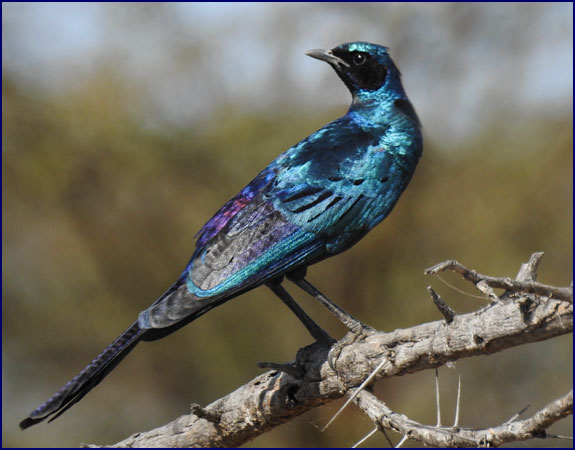
Burchell's Starling |
A herd of African buffalo grazed near the edge of the floodplain;
they eyed us suspiciously as we approached. Further upriver we
came across a herd of waterbuck; they look like a larger and
furrier version of our white-tailed deer. They have a perfect
white circle on their hindquarters like a target, and the males
have beautiful spiraled horns. Stan told us they live near the water so
they can go in it to escape predators.
Leaving
the floodplain behind, we crossed the main road and followed a
track through the local game reserve. The park was a long narrow
strip that went along the border; we drove in Zimbabwe but
Botswana was just to our right. A fifty foot swath had been
cleared of vegetation along the border, and on the Botswana side
we could see houses and businesses. As far as being out in the
wild goes, it was disappointing - especially coming after
Hwange.
Despite the lack of isolation,
there were a lot of animals in the park. A group of elephants
stood near the road with a small baby. We spent quite a while
watching the youngster; he was experimenting with waving his trunk
and his front leg around, trying to figure out how they worked.
Several
giraffes strolled by, but they were on the Botswana side of the
border so we couldn’t get close. But a bit further on we came
across more, and this time not only were they in Zimbabwe, but
they were close to the road – we were thrilled to have our first
good close-up giraffe encounter. We stopped for sundowners and had
a glass of wine while watching the sun set behind an acacia tree.
Vervet monkeys played in the upper branches.
It was quite dark by
the time we headed back, retracing our route along the border.
Stan drove slowly while holding a spotlight, sweeping it back and
forth looking for the glint of eyes. A rabbit crouched near the
road, an African hare - quite probably the animal I would least
want to be in Africa. Not long after, we saw a jackal, out hunting
in the dark.
Suddenly the spotlight caught a
flash of tawny movement; four lions, on the prowl! There were
three males and one female, stalking through the bush, hunting.
Stan guessed that they were heading to the river to wait for the
buffalo herd to go down to drink. We followed the lions all the
way to the paved road; they crossed it in single file and
disappeared into the night.
Back
at the lodge, we had dinner under the tree, joining about eight
other guests. The food was good, but not as outstanding as at Camp
Hwange. A herd of impala grazed near the lawn sprinklers,
attracted by the fresh green grass. Jineen stealthily stalked them
to see how close she could get, but they took off when she came
near.
There was a campfire, but it had
died down to just a few glowing embers. Nick and Jineen got it
going again, and we sat around it sharing some liqueur and
talking. It was not like Camp Hwange, where we sat at the campfire
with the guides, listening to their stories and hearing the lions
and elephants call in the night. We all agreed that Imbabala was
more luxurious than Hwange, but far less wild.
That evening, we learned via the
internet about the shooting of Cecil the Lion in Hwange National
Park. We were horrified. Personally I find the concept of trophy
hunting abhorrent, and when involving rare or endangered animals
it is truly incomprehensible to me. Later, upon hearing the tragic
news of Quinn’s death, we had cause to wish that it could have
been Nxaha that was shot instead of Cecil.
July
26
Stan took us out for the morning
game drive as the sun came up. It was quite cold; we spread the
ponchos provided in the vehicle over our laps. A squirrel
chattered down at us from a nearby tree, leaping from branch to
branch. As we headed down to the floodplain we had to stop because
a herd of buffalo was blocking the road - rush hour in Zimbabwe. A
fish eagle surveyed the scene from the top of a dead tree. Hippos
floated in a pink river in the sunrise.
All
of the usual suspects were there; warthogs and waterbucks wandered
across the floodplain and a group of impala were silhouetted
against the water. Several white-backed vultures sat in their
nests in the tops of trees; through the binoculars we could see
flies buzzing around them. A large baboon tried to walk underneath
a kudu bull while it was nibbling from a tree; the kudu wasn’t
having it and chased the baboon away.
|
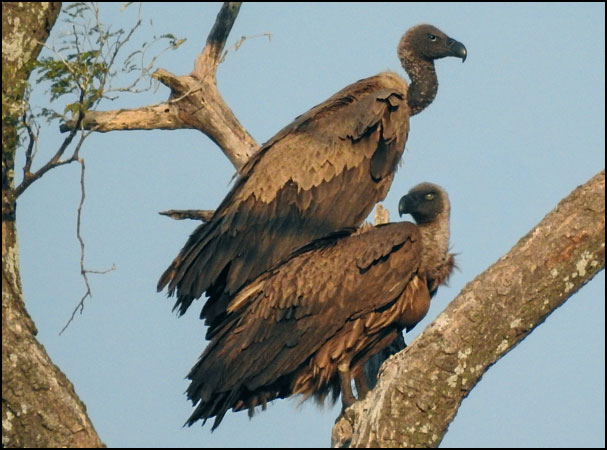
White-backed Vultures |
Stan
took us to the quadripoint where four countries come together:
Zimbabwe, Botswana, Zambia and Namibia. We could see trucks lined
up waiting their turn to take the ferry across the river to
Zambia; Stan told us that sometimes the line gets so long they
have to wait for days.
We crossed the paved road and took
the same track along the border as the previous evening. We added
several new birds to the list, such as the brown-crowned tchagra,
the red-billed firefinch, and the white-bellied sunbird. A kori
bustard walked among the bushes; these attractive turkey-sized
birds are Africa’s heaviest flying bird.
|
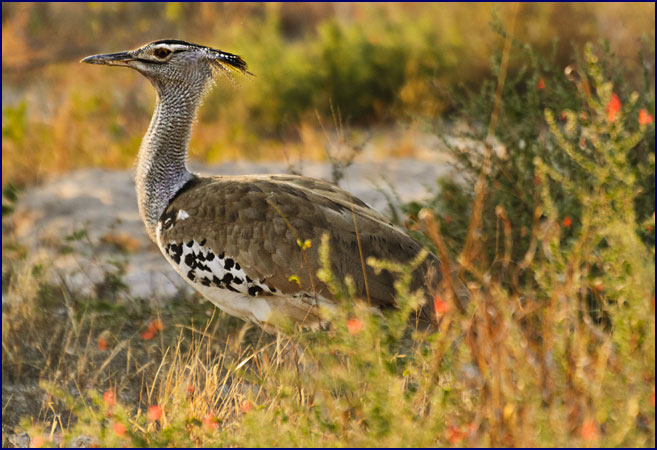
Kori Bustard
|
We
came across a group of seven giraffes, eating leaves from the
treetops. Before long they were joined by four more, one with a
young baby. A big male seemed to be courting one of the females.
We delighted in watching these graceful gentle creatures.
We
stopped for tea under an acacia tree. Vervet monkeys ran up the
tall trunk and peered down at us from the upper branches. I
collected some of the curlicue acacia seedpods that had fallen to
the ground.
We headed back, retracing our
route along the border. There were lion tracks along the dusty
road; surely these were made by our friends from the night before.
We traced the prints back to the lodge, where they turned off just
before the buildings.
Because
the morning game drive at Imbabala finished before eleven, we had
arranged for Stan to take some of us back out mid-day for an extra
drive. George, Rosemary and Nick stayed at the lodge, but Sally,
Mike, Jineen, Mary and I, went ‘birding.’ It was a chance to
really focus on the birds, and take as much time as we wanted
watching and identifying them. We started at 11:30 and stayed out
for three hours. Although initially I was more interested in
photographing the birds than identifying the different LBJs, I
soon found myself becoming increasingly interested in learning
which was which - though I do have to admit I prefer the colorful
ones to the LBJs.
We
started out along the river flats, where there was an abundance of
waterfowl. We saw glossy ibis, green-backed herons and a black
crake. Several large crocodiles lounged by the river with their
mouths wide open to dissipate heat, and to our amazement white
egrets stood unconcerned just inches from those powerful gaping
jaws. We watched an open-billed stork fly past, the origin of his
name evident by the gap in his beak. Some of the new birds for
Sally’s list included the white-faced whistling duck, the
coppery-tailed coucal, and the brown-hooded kingfisher. Best of
all, we also saw a tiny malachite kingfisher, brilliant with a
metallic blue back and rufous breast.
|
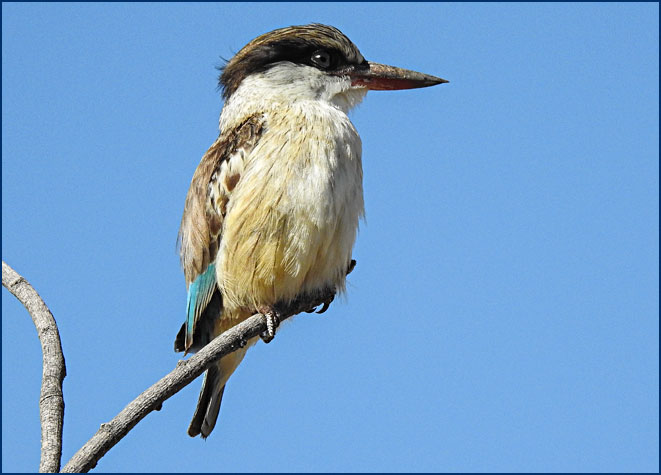
Brown-hooded Kingfisher |
Moving
away from the river, we followed a dirt road among the trees and
scrubby brush. We passed an elephant carcass; the meat had been
eaten but the skeleton remained, bound together with tough sinew
and skin. Several kudus hung out in the shade, and we watched a
troop of baboons. A black-backed jackal sauntered past, and a
vervet monkey silently regarded us from a termite mound.
There were an amazing variety of
birds; robin chats, crested barbets, wagtails, and the beautiful,
colorful white-fronted bee-eater.
We saw a grey hornbill and a Bradfield's hornbill. Trying
to get photos of lilac-breasted rollers in flight, we would focus
our cameras on these vibrant birds, and then Stan would open the
vehicle door to make them fly – even so it was almost impossible
to be quick enough to get the shot, and we ended up with many
photos of unfocused blurs of color and empty twigs.
|
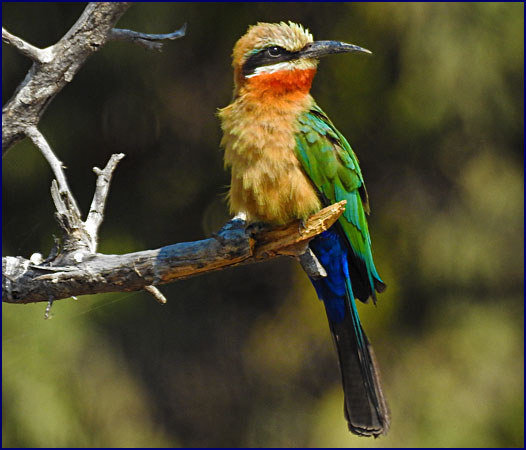
White-fronted
Bee-eater
|
Back
at Imbabala, we had several free hours to fill. At our rondoval, I
watched as an ant struggled to drag a dead moth, twenty times his
size, across our porch floor – several of his friends joined him
to get the job done. I walked around the grounds. Doves drank from
a tiny water hole beneath the trees, and blue-eared starlings
pecked on the lawn. A tropical boubou perched in the big tree by
the dining table. A bushbuck wandered past, unconcerned by my
presence. A staff member cautioned me not to go too close to the
underbrush along the edge of the lawn, as who knew what might be
lurking there.
Exploring camp, I was able to get
quite close to a warthog; to my surprise I saw that he had a
porcupine quill stuck in the center of his face. He grazed on the
lawn, kneeling to better reach the grass, the quill protruding
from his forehead like a horn. Later I showed a photograph of him
to Stan and told him I had sighted a new animal - the rare and
elusive African Unicorn!
|
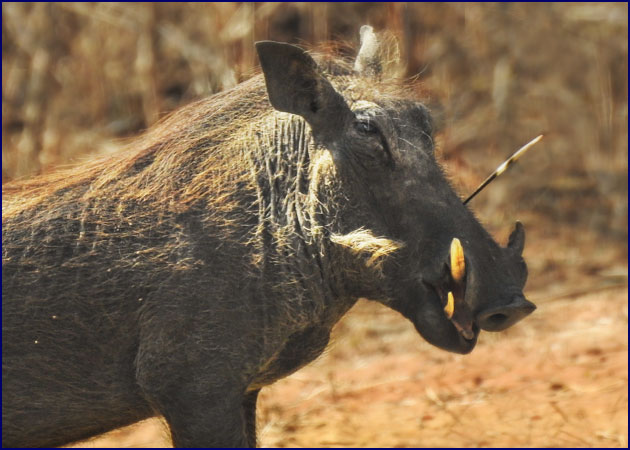
A Unicorn!
|
At
4:30 we went for an evening river cruise on the Zambezi River. We
walked down the path to the river and boarded a small barge with a
flat deck. Though it probably would have comfortably held 20
people, there was just our group on board – minus George, who
was not feeling well. We sat in deck chairs, and could move about
the boat easily. It was a beautiful evening, and the cruise was
very relaxed and peaceful. We were sorry George was not there to
enjoy it with us.
|
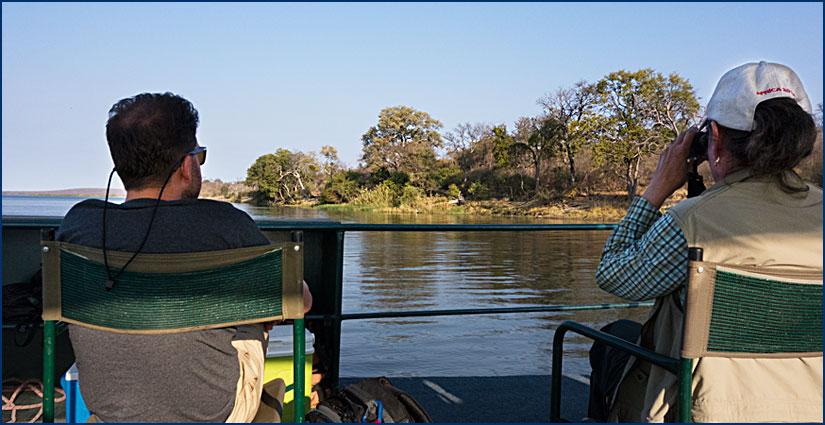
On the Zambezi
|
There
were hippos in the water, and baboons along the shore. Swallows
circled round us – Stan said they build their nests on the
outside of the boat. We watched a pied kingfisher as it hovered
and dived. A white-browed robin chat hopped along the riverbank,
and a brown-hooded kingfisher perched on a tree root. Sally was
keeping a bird list – by the end of the day she was up to 146
new birds for the trip. A small crocodile floated in the shallows;
the young ones are far more colorful and beautiful than the
adults.
A
little bushbuck walked along the riverbank, and a group of
waterbuck browsed among the reeds. Some two hundred African
buffalo came down to the grassy floodplain near the river to
graze. Stan stopped the boat and brought out wine and
gin-and-tonics, and served biltong,
dried strips of surprisingly good meat jerky. We had Sundowners
with the buffalo.
We
turned around and headed west toward the setting sun. The boat
glided smoothly across the glassy water as the sky turned from
pastel to deep rose. A pair of ibis flew across as we watched the
sun go down behind an acacia tree.
We
had dinner back at the lodge, and afterwards Stan took us out for
a night drive. George was running a fever so he didn’t come, and
Rosemary and Nick stayed with him. It was very cold again; this
time we wore the ponchos provided in the vehicle.
As we went out the driveway
Stan’s spotlight found several hippos that were lying down
sleeping in the bushes just behind the lodge. We were surprised to
see them so far from the water, but Stan told us they will travel
up to 15 or 20 kilometers from the river at night if the grazing
is good, returning to the water by daybreak.
Scanning back and forth with the
light, Stan spotted a well-camouflaged brown bird crouching down
in the grass - a fiery-necked nightjar, another new one for the
list. We turned up the familiar road along the border, and for a
long while we saw nothing except the occasional impala. We passed
a few elephants and a couple of giraffes, but having seen these in
the daytime we didn’t pause – we were looking for nocturnal
animals. Just when we thought we wouldn’t see anything new
Stan’s spotlight found a civet; we got a brief look at this
sleek lithe-bodied animal which looks a little like a cross
between a cat and a weasel. A
bit further on we got a quick glimpse of a white-tailed mongoose
as it dove into the underbrush; this is the largest member of the
mongoose family, tall and handsome with a long bushy white tail.
Again Stan’s light caught the
gleam of eyes, and we could faintly see several shadowy shapes
moving beneath the trees. Hyenas!
It was a group of five, prowling along on the Botswana side
of the border. Stan turned off the motor and the lights. ‘Bleeaagh!’
he suddenly called out into the night, imitating the
high-pitched sound of a buffalo calf in distress. We waited, and
Stan called again. ‘Bllleeaagghhh!!’
After a few minutes he turned the light back on - and
hyenas were right there, just behind our vehicle! These
unattractive scavengers were eagerly looking for an easy meal of
wounded buffalo calf. We were impressed. Stan the Hyena Whisperer!
Back
at Imbabala we heard a hyena calling - had they followed us home?
I sat talking with Nick in the lounge area after the others had
gone to bed. He had brought his laptop and was downloading his
photos; I was a bit envious - I would have to wait until I got
home to look at mine. Suddenly we heard a commotion outside; loud
raucous voices seemed to be yelling, ‘Ow!
Ow! Ow! ‘ We realized it was a troop of monkeys in the big
tree just outside the bar.
In the cabin, Jineen and I listened to
the rhythmic sounds of the night birds. We heard the soft
ascending whoo-oop, whoo-oop
of the hyenas as they called to one another. Then in the wee hours
of the night we heard a loud shrill noise. We couldn’t figure
out what made it; it didn’t sound like a bird - was it a monkey?
We found out in the morning that it was the camp’s motion
detector alarm; George had come out of his cabin and accidentally
set it off. Our previous camp at Hwange had definitely been more
remote and wild than Imbabala. But not as wild as where we were
going next!
|